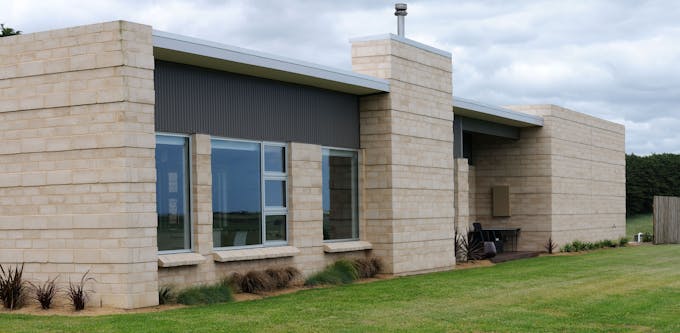When Australian potter and ceramic artist Peter Collier set out to build a home for his family in 1994, he discovered that the undertaking would be too expensive for him and that the bank was unwilling to provide loans.
Undeterred, Collier channelled his expertise into working with clay and similar materials to devise a building block which would be cheaper than existing options on the market. The result of his experiment was a blend of timber waste, sand, cement, and binders that enabled Collier to build his dream home within budget.
His invention soon caught the attention of others in the industry and over the next two decades, it has been refined, patented, and commercialised as Timbercrete, a sustainable, low-carbon, and climate-resilient building material set to revolutionise how the industry constructs its buildings.
The Colliers distributed Timbercrete using a franchise model until 2014, when they set up Ligna Group, the company which was set up to develop and manage the distribution of TimberCrete. Recently, Ligna Group unveiled Ligna Stone, a new and improved version of the original technology.
The material, certified safe by Australian and New Zealand building codes, is also one of the only bricks that sequesters carbon dioxide, due to the timber and sawdust that is mixed into each brick.
Tony Rule, managing director of Ligna Group tells Eco-Business that that these lightweight blocks reuse waste building materials, require less energy to produce than clay-fired bricks, and are more fire and flood resistant than conventional alternatives.

A house made using TimberCrete blocks. Image: Ligna Group
“Our proven product has the benefit of over 15 years of development and refinement, with over 2,000 homes built around Australia,” says Rule.
TimberCrete is one of many creative solutions emerging in Australia’s construction industry as it grapples with big challenges such as climate change, population growth from 24 million today to more than 40 million people by 2060, and skyrocketing housing prices.
The product, along with other cutting-edge ideas, will be on display at the upcoming DesignBUILD exhibition and conference, one of Australia’s oldest and biggest events for the architecture and construction industry.
Now in its 30th year, DesignBUILD will be held at the Melbourne Convention and Exhibition Centre from 4 to 6 May, and will bring 6,600 of the country’s architects, landscape designers, and product manufacturers together to jointly develop new solutions for the building industry.
The three-day event will also feature a trade exhibition with more than 300 brands on display; seminars on themes such as sustainability, compliance, and innovation; and myriad networking sessions.
Economics and policy expert Kerry Barwise, who has led the Australian Construction Industry Forum’s annual trend forecasting exercise for three years and will be speaking at the DesignBUILD event, notes that given the rapid population growth expected in Australia, “the pressure is on for architects to make buildings more productive”
This means designing better but also cheaper buildings, so they remain affordable, explains Barwise, who is also director of Sydney-based advisory firm Barwise Consulting.
The building sector, which according to the United Nations Environment Programme accounts for a third of global greenhouse gases, must also reduce energy use to help fulfil Australia’s climate change pledge to reduce emissions by 26 to 28 per cent below 2005 levels by 2030.
Even if these targets are met, a certain degree of climate change is inevitable, Barwise says. In Australia, this will mean more frequent and intense floods, bushfires, and heat waves. Building practices will have to adapt so homes and workplaces can withstand these changes.
And where damage is unavoidable, the industry should offer cheap and quick ways to rebuild homes, he adds.
Ali Mead, DesignBUILD event manager, notes that as architects, material manufacturers, engineers and builders - who have traditionally worked in silos - recognise the scale and complexity of these challenges, there is growing collaboration within the sector.
When professionals at various stages of the building value chain start working together from early in the construction process, it reduces the time and resources wasted when design ideas are found to be unfeasible for implementation, she explains.
Increased interaction also opens up new learning and growth opportunities, says Mead.
“DesignBUILD is unique because it brings the industry together and educates people on the latest technologies, legislation, and trends”, she adds. “These are issues everyone in the industry should be thinking about”.
“
It’s important for the industry to get fresh perspectives from people who have not been jaded by years of developments.
Ali Mead, DesignBUILD event manager
Grooming the next generation
To commemorate its 30th anniversary, DesignBUILD is also launching two new initiatives –called Incubator and Raw – to give lesser known entrepreneurs and students a chance to showcase their products and ideas as well as network with industry veterans.
“It’s important for the industry to get fresh perspectives from people who have not been jaded by years of developments,” shares Mead. “Young people are inevitably more adaptable to technology and have different, fresh ideas”.
As part of the Incubator, the organisers invited companies which have never exhibited at DesignBUILD before to submit their innovative ideas to make buildings more sustainable and affordable, for chance to win one of five free display booths at the show.
Over 30 companies applied for this inaugural competition, with Timbercrete emerging as one of the winners.
Another winning idea is called Swags with Walls, which aims “to put an end to homelessness, once and for all”.
The product is an innovation by Brisbane-based social enterprise Street Swags, which manufactures and distributes climate-proof, durable tents - known in Australian slang as swags - to homeless people in the country.
Swags with Walls is a free-standing, wooden home which can be set up on private plots of land or in camping parks for mobile homes. The units, which cost between A$9,000 for a basic model to A$34,000 for a model equipped with a washroom and veranda, can be delivered to residents on a truck.
All models are structurally safe and compliant with national building codes. Jean Madden, managing director of Street Swags, says: “I got sick of hearing about the lack of affordable housing, so I have gone and made housing cheaper”.
Competition for inspiration
DesignBUILD’s other initiative - the Raw competition – targets architecture students. This year’s competition will see students from two Melbourne based tertiary institutes - RMIT University and Deakin University – competing to design the conference’s entrance feature and networking hub respectively.
RMIT University students will submit design proposals for the conference’s entrance area, and the winning team will see their design built at the venue.
DesignBUILD’s Mead shares that the teams “have all the very real restrictions that a professional company would have, such as health and safety considerations, and a fixed budget”.
This will give students a taste of working on a project in the real world, and they can also approach the exhibitors at the show to use their building materials in their work, she says.
Meanwhile, Deakin University teams will visualise how the event’s main networking and bar area should look.
While their projects will not be constructed due to time constraints, the top entries will be displayed on screens at the event. Winning students will also have the opportunity to present to 200 industry leaders at a networking evening.
Diego Fullaondo, senior lecturer in architecture design, Deakin University, says that “these students are the young professionals of the future, and will be deciding what types of designs get built in the years to come”.
“It’s good that the industry pays attention to students and nurtures interaction through such programmes”, he adds.
Mead notes that “there is so much that young professionals can learn from their predecessors, and in turn, they have fresh perspectives to offer.”
“It is vital to encourage their participation in this and future shows,” she adds.
Click here to find out more about DesignBUILD 2016 and register for the event.


















